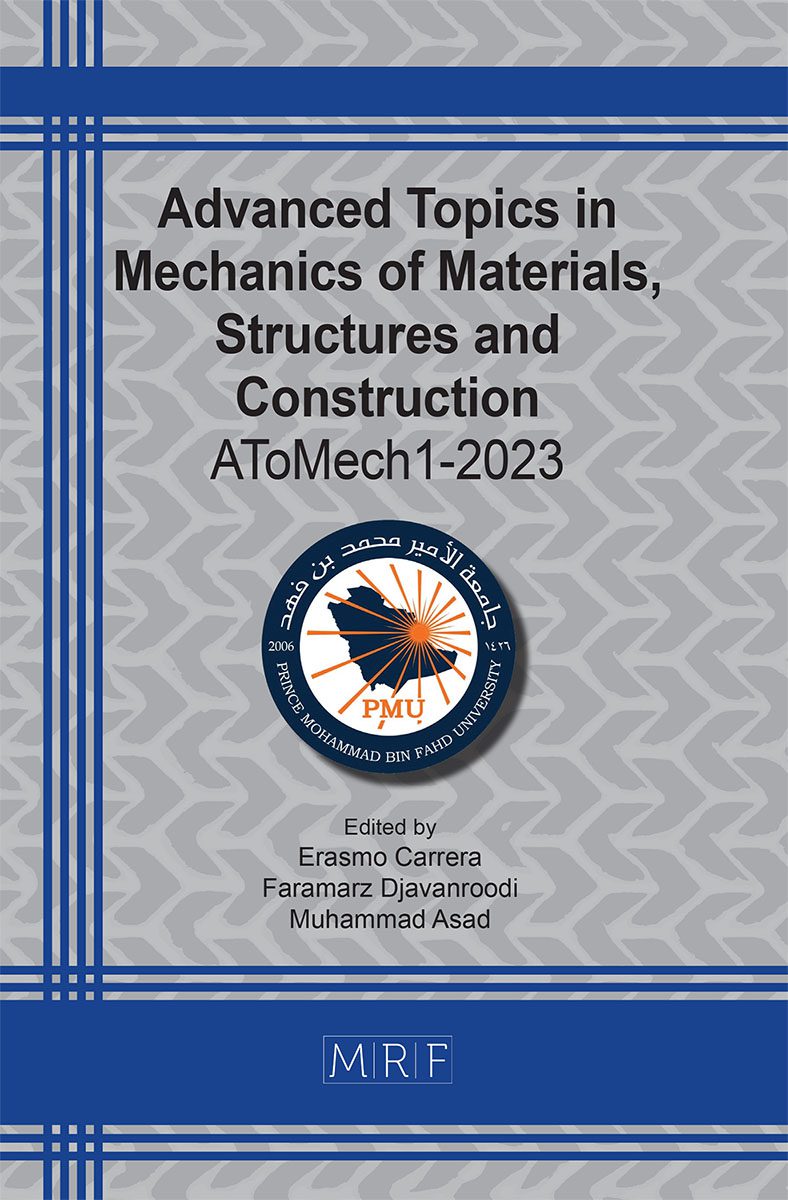Von mises stress distribution along the cruciform specimen under biaxial loading: geometric variation effect
Abdul Mateen Mohammed, Jaya KandaSamy, Bhavani Venkata Yashwanth Dasari, Lingala Syam Sundar
download PDFAbstract. The aim of this work is to optimize the geometry of the cruciform specimen required for in-plane biaxial testing where the failure has to occur in the central gauge region. The specimen has three different zones with three different thickness, i.e., (i) along the arm, (ii) Milled region and (iii) along the central gauge region. The geometric variables in the specimen are the radii at four different locations in the geometry (i) central gauge (ii) radius of the slots milled along the arm, corner radius at (iii) Milled region and (iv) at the intersection of arms. The Taguchi method was realized for the design of experiments considering these four factors varied at three level. However, the effect of the variation in the thickness was studied independently. During which the thickness at the central region was maintained constant to 0.7mm, whereas the thickness at the other two positions were varied from 3 mm to 3.5mm and 1 to 1.5 mm respectively. In the first set of experiments the Von Mises stress was maximum at the gauge section along with a portion of it also being appearing along the milled region on the arm of the specimen. However, for the second set of experiments the maximum stress occurred along the gauge region for the three geometries. Later, Taguchi analysis indicated the radius of the slots milled along the arm is the prime statistically influencing factor and the radius at the interface of the arm section is the second statistically influencing factor. Whereas the other two radii are found to be statistically non-influencing factor when considered individually. However, a strong interaction has been observed between all the four parameters.
Keywords
Biaxial Stress, Cruciform Specimen, Taguchi, Stress-Strain
Published online 8/10/2023, 13 pages
Copyright © 2023 by the author(s)
Published under license by Materials Research Forum LLC., Millersville PA, USA
Citation: Abdul Mateen Mohammed, Jaya KandaSamy, Bhavani Venkata Yashwanth Dasari, Lingala Syam Sundar, Von mises stress distribution along the cruciform specimen under biaxial loading: geometric variation effect, Materials Research Proceedings, Vol. 31, pp 385-397, 2023
DOI: https://doi.org/10.21741/9781644902592-40
The article was published as article 40 of the book Advanced Topics in Mechanics of Materials, Structures and Construction
![]() Content from this work may be used under the terms of the Creative Commons Attribution 3.0 license. Any further distribution of this work must maintain attribution to the author(s) and the title of the work, journal citation and DOI.
Content from this work may be used under the terms of the Creative Commons Attribution 3.0 license. Any further distribution of this work must maintain attribution to the author(s) and the title of the work, journal citation and DOI.
References
[1]. Jones, C., 2001. “Biaxail testing of polymer composites”. Mater. World 9 (11), 19-21.
[2]. Demmerle S, Boehler JP (1993), “Optimal design of biaxial tensile cruciform specimens”. J Mech Phys Solid 41(1):143- 181 https://doi.org/10.1016/0022-5096(93)90067-P
[3]. Makinde A, Thibodeau L, Neal KW, Lefebvre D (1992), “Design of a biaxial extensiometer for measuring strains in cruciform specimens”. Exp Mech 32(6):132-137 https://doi.org/10.1007/BF02324724
[4]. Tiernan, P.; Hannon, A. Design optimization of biaxial tensile test specimen using finite element analysis. Int. J. Mater. Form. 2014, 7, 117-123. https://doi.org/10.1007/s12289-012-1105-8
[5]. Hannon, A.; Tiernan, P. A review of planar biaxial tensile test systems for sheet metal. J. Mater. Process. Tech. 2008, 198, 1-13. https://doi.org/10.1016/j.jmatprotec.2007.10.015
[6]. Zhutao Shaoa, Nan Lia, Jianguo Lin, The optimisation of cruciform specimen for the formability evaluation of AA6082 under hot stamping conditions, Procedia Engineering 207 (2017) 735-740. https://doi.org/10.1016/j.proeng.2017.10.821
[7]. Zheng Lu, Jia-Yu Zhao, Chang-Yu Zhou, and Xiao-Hua He, Optimization Design of a Small-Sized Cruciform Specimen for Biaxial Fatigue Testing, Metals 2020, 10, 1148; https://doi.org/10.3390/met10091148
[8]. Liu,W.; Guines, D.; Leotoing, L.; Ragneau, E. Identification of sheet metal hardening for large strains with an in-plane biaxial tensile test and a dedicated cross specimen. Int. J. Mech. Sci. 2015, 101, 387-398. https://doi.org/10.1016/j.ijmecsci.2015.08.022
[9]. Kwon, H.J.; Jar, P.-Y.B.; Xia, Z. Characterization of biaxial fatigue resistance of polymer plates. J. Mater. Sci. 2005, 40, 965-972. https://doi.org/10.1007/s10853-005-6515-2
[10]. Kulawinski, D.; Nagel, K.; Henkel, S.; Hübner, P.; Fischer, H.; Kuna, M.; Biermann, H. Characterization of stress-Strain behavior of a cast trip steel under different biaxial planar load ratios. Eng. Fract. Mech. 2011, 78, 1684-1695. https://doi.org/10.1016/j.engfracmech.2011.02.021
[11]. Kuwabara, T. Biaxial stress testing methods for sheet metals. In Comprehensive Materials Processing; Elsevier: Amsterdam, The Netherlands, 2014; Volume 1, pp. 95-111. https://doi.org/10.1016/B978-0-08-096532-1.00106-0
[12]. Ackermann, S.; Lippmann, T.; Kulawinski, D.; Henkel, S.; Biermann, H. Biaxial fatigue behavior of a powder metallurgical trip steel. Frat. Ed Integrita Strutt. 2015, 34, 580-589. https://doi.org/10.3221/IGF-ESIS.34.64
[13]. ISO/CD 16842. Metallic Materials-Sheet and Strip-Biaxial Tensile Testing Method Using Cruciform Specimen; ISO: Geneva, Switzerland, 2014.
[14]. Mohammed A M, Sayyadh R, Dasari V R S, Mohammed M H, Stress distribution along the cruciform geometry under pure in plane biaxial loading condition. Journal of the Brazilian Society of Mechanical Sciences and Engineering (2019) 41:416. https://doi.org/10.1007/s40430-019-1928-z
[15]. Yu Y, Wan M, Wu XD, Zhou XB (2002) Design of a cruciform biaxial tensile specimen for limit strain analysis by FEM. J Mater Process Technol 123:67-70. https://doi.org/10.1016/S0924-0136(02)00062-6































